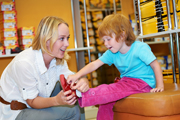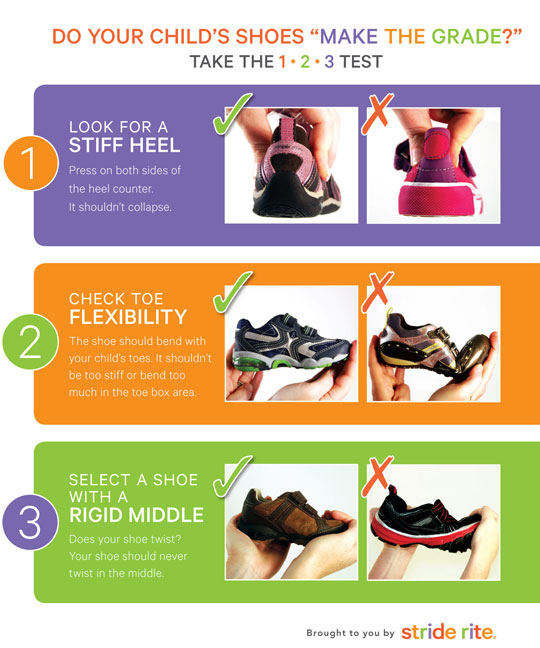Parents: Avoid kids’ foot problems with the right shoes
Parents should scuff-up the soles of new boots, or purchase adhesive rubber soles, much the same as we do for children as they learn to walk in shoes, to provide greater traction.
Before you head to the store to buy your kids shoes, follow these helpful guidelines to prevent or minimize foot problems from poorly fitting or worn out shoes.
Shoes should fit
Your child’s feet can grow up to two sizes in six months, so you need to account for growth when buying shoes. That doesn’t mean you should buy shoes that are too big—oversized shoes cause the foot to slide forward, putting excessive pressure on the toes. A good fit is about a finger’s width from the end of the shoe to the tip of the big toe.
Tight shoes can cause blisters, corns and calluses on your child’s toes, blisters on the back of the heels or worse, ingrown nails, which can become infected. Signs of infection from ingrown nails include pain, redness or fluid draining from the area. If you notice any of these symptoms, schedule an appointment with a foot and ankle surgeon, who can perform a simple, safe in-office procedure to remove the nail.
Shoes wear out
Shoes lose their shock absorption over time, so inspect new and old shoes for proper cushioning and arch support. Replace any shoes with wear and tear around the edges of the sole. When buying shoes, check to see that the toe box flexes easily and the shoe doesn’t bend in the middle of the sole.
Worn-out shoes elevate the risk for heel pain, Achilles tendonitis and even ankle sprains and stress fractures.
Children with flat feet
Children with flat feet need shoes with a wide toe box, maximum arch support and shock absorption. The best shoes to buy are oxford, lace-up shoes that have enough depth for an orthotic insert, if necessary.
Foot of the Class
AFTER WEARING FLIP-FLOPS ALL SUMMER, STUDENTS HEAD BACK TO SCHOOL WITH PAINFUL FEET
The sounds of back to school season include the ringing of school bells and cash registers, the slamming of locker doors, the noisy ruckus of school hallways and cafeterias, and the moans and groans of students over tests, homework, relationships, and increasingly, their aching feet.
Flip-flops are the summer footwear of choice for many students. But while these sandals are inexpensive and stylish, they don’t cushion or support the foot, leading to problems. After wearing flip-flops all summer, some students will head back to school this fall with foot pain and even injuries. The American College of Foot and Ankle Surgeons (ACFAS) reminds parents and students that foot pain isn’t normal and can be reduced or eliminated.
“People may not realize that even into your mid-teens, there’s new bone growing in your heel,” says Michael Cosenza, DPM, AACFAS, a foot and ankle surgeon in Ukiah, Calif. “Flip-flops don’t cushion the heel, so repetitive stress from walking can inflame that heel bone growth area and cause pain and tenderness.”
Heel pain and arch pain rank among the most common complaints among students who wear flip-flops. Other flip-flop feet problems students can take back to school include inflammation of the Achilles tendon, painful pinched nerves, sprained ankles, broken or sprained toes, cuts and scrapes, plantar warts, Athlete’s foot, and callus build-up on the heels and toes.
Foot and ankle surgeons can usually reduce or eliminate students’ foot pain with simple treatment methods including stretching exercises, ice massage, anti-inflammatory medications, and custom or over-the-counter shoe inserts.
Back-to-school season will always be painful for some students, but it doesn’t need to involve foot pain.
Tips for Finding Proper Fitting Shoes for Your Child
 During the back-to-school season and throughout the year, one of the most important purchases on any parent’s shopping list should be a pair of properly fitting shoes for their child. For many parents, shoe shopping may seem easier than a pop quiz in gym class, but several important factors should be considered:
During the back-to-school season and throughout the year, one of the most important purchases on any parent’s shopping list should be a pair of properly fitting shoes for their child. For many parents, shoe shopping may seem easier than a pop quiz in gym class, but several important factors should be considered:
- Children’s Feet Change With Age. Shoe and sock sizes may change every few months as a child’s feet grow.
- Shoes That Don’t Fit Properly Can Aggravate the Feet. Always measure a child’s feet before buying shoes, and watch for signs of irritation.
- Never Hand Down Footwear. Just because a shoe size fits one child comfortably doesn’t mean it will fit another the same way. Also, sharing shoes can spread fungi like athlete’s foot and nail fungus.
- Examine the Soles. Children may wear through the sole of shoes more quickly than they outgrow shoes. Uneven wear in the toe or heel can indicate a foot problem that should be checked by a podiatrist.
- Take Your Child Shoe Shopping. Every shoe fits differently. Letting a kid have a say in the shoe-buying process promotes healthy foot habits down the road.
- Always Buy for the Larger Foot. Feet are seldom precisely the same size.
- Buy Shoes That Do Not Need a “Break-In” Period. Shoes should be comfortable immediately. Also make sure to have your kid try on shoes with socks or tights, if that’s how they’ll be worn.


